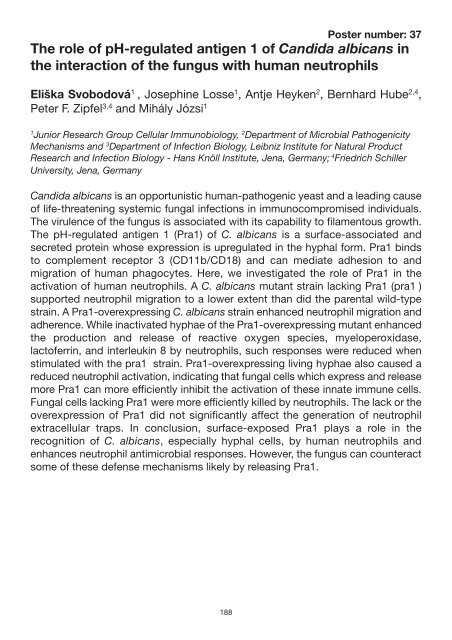Candida Infection Biology – fungal armoury, battlefields ... - FINSysB
Candida Infection Biology – fungal armoury, battlefields ... - FINSysB
Candida Infection Biology – fungal armoury, battlefields ... - FINSysB
Create successful ePaper yourself
Turn your PDF publications into a flip-book with our unique Google optimized e-Paper software.
Poster number: 37<br />
The role of pH-regulated antigen 1 of <strong>Candida</strong> albicans in<br />
the interaction of the fungus with human neutrophils<br />
Eliška Svobodová 1 , Josephine Losse 1 , Antje Heyken 2 , Bernhard Hube 2,4 ,<br />
Peter F. Zipfel 3,4 and Mihály Józsi 1<br />
1 Junior Research Group Cellular Immunobiology, 2 Department of Microbial Pathogenicity<br />
Mechanisms and 3 Department of <strong>Infection</strong> <strong>Biology</strong>, Leibniz Institute for Natural Product<br />
Research and <strong>Infection</strong> <strong>Biology</strong> - Hans Knöll Institute, Jena, Germany; 4 Friedrich Schiller<br />
University, Jena, Germany<br />
<strong>Candida</strong> albicans is an opportunistic human-pathogenic yeast and a leading cause<br />
of life-threatening systemic <strong>fungal</strong> infections in immunocompromised individuals.<br />
The virulence of the fungus is associated with its capability to filamentous growth.<br />
The pH-regulated antigen 1 (Pra1) of C. albicans is a surface-associated and<br />
secreted protein whose expression is upregulated in the hyphal form. Pra1 binds<br />
to complement receptor 3 (CD11b/CD18) and can mediate adhesion to and<br />
migration of human phagocytes. Here, we investigated the role of Pra1 in the<br />
activation of human neutrophils. A C. albicans mutant strain lacking Pra1 (pra1 )<br />
supported neutrophil migration to a lower extent than did the parental wild-type<br />
strain. A Pra1-overexpressing C. albicans strain enhanced neutrophil migration and<br />
adherence. While inactivated hyphae of the Pra1-overexpressing mutant enhanced<br />
the production and release of reactive oxygen species, myeloperoxidase,<br />
lactoferrin, and interleukin 8 by neutrophils, such responses were reduced when<br />
stimulated with the pra1 strain. Pra1-overexpressing living hyphae also caused a<br />
reduced neutrophil activation, indicating that <strong>fungal</strong> cells which express and release<br />
more Pra1 can more efficiently inhibit the activation of these innate immune cells.<br />
Fungal cells lacking Pra1 were more efficiently killed by neutrophils. The lack or the<br />
overexpression of Pra1 did not significantly affect the generation of neutrophil<br />
extracellular traps. In conclusion, surface-exposed Pra1 plays a role in the<br />
recognition of C. albicans, especially hyphal cells, by human neutrophils and<br />
enhances neutrophil antimicrobial responses. However, the fungus can counteract<br />
some of these defense mechanisms likely by releasing Pra1.<br />
188


